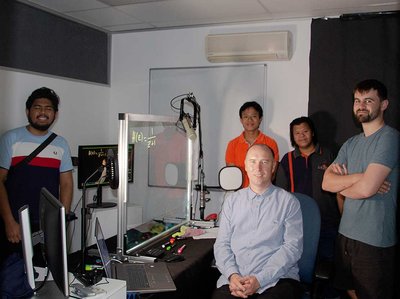
Dr Mathew Legg using the lightboard system.
Dr Mathew Legg, supported by fourth year international engineering students at Massey University, has created an innovative real-time online teaching method that helps to recreate the feeling of face-to-face learning.
Dr Legg’s team, including BE Hon (Electrical and Computer Engineering) students Danny Sukor, Adam Asrar and Muhammad Izzuddin and with assistance from Baden Parr (PhD student), created the system after noticing a ‘disconnect’ between student and teacher in other online learning setups.
The result of their work, a lightboard (learning glass) system, allows teachers to write and project images while still being seen by the students during live online lectures.
Dr Legg, a Senior Lecturer in the Department of Mechanical and Electrical Engineering, SF&AT, says this system addresses this issue of interacting with students.
“There is a real gap between face to face and digital learning, but this really helps bridge that as students can see the teacher explaining the concepts with facial expressions and hand gestures.”
The lightboard allows teachers to draw and write in real-time as the students are watching and interacting live on Zoom. This dynamic interaction makes it perfect for subjects that feature diagrams and equations.
A lightboard is a transparent low-iron glass with LED lighting around its edge that makes special markers fluoresce. This is positioned between the camera and lecturer and uses special software that flips the writing for those on the other end of the camera. In addition, augmented reality techniques allow the overlay of rich dynamic content such as PowerPoint presentations, live code, figures, and 3D models.
While there are other teaching methods that allow drawing, such as tablets, these methods don’t also allow the teacher to be seen simultaneously (other than in a small camera feed in a corner of the screen). This leads to a less personable experience for students.
Dr Legg says it took a bit of time to figure out a system that could provide good images, lighting, and sound. However, in the end he is confident that this method has many benefits compared to other forms of online learning.
“You could set this up in a classroom and you could be simultaneously teaching in person and to those online live, and neither would be at a disadvantage.”
The students behind this also hope to see it take off as online learning becomes more mainstream.

The team behind the new system; Dr Legg and Electrical and Computer Engineering students Danny Sukor, Adam Asrar and Muhammad Izzuddin and with assistance from Baden Parr.
Mr Sukor, one of the contributing students, says they’re looking at some similar concepts being done in America, but this system seems to be the only one of its kind in New Zealand and is available at a significantly lower cost: “We hope this system becomes integrated into online learning as we continue.”
Compared to a standard Zoom based lecture, other benefits of this system are increased privacy and efficiency.
With this system, users are able to record their own screen and voice in isolation, allowing students to still interact in the lecture while maintaining their privacy and anonymity if desired. Thanks to this flexible recording approach, videos can be uploaded immediately without the need for consent forms or editing.
The system also has sound and video editing built in. Everything seen is done live while filming, meaning there is nothing required in post-processing as normally would be the case.
This system has already been used in Massey’s Engineering courses with great feedback. Students have said the best part was being able to see the lecturer writing and interacting while explaining concepts, rather than simply listening to a disconnected voice over of a prepared slideshow.
Harry Cull, a second-year Mechatronics student says: “it was definitely the closest an online lecture felt to in person.”
For any enquiries about incorporating a Lightboard system into your teaching workflow, please reach out to Dr. Mathew Legg (m.legg@massey.ac.nz).